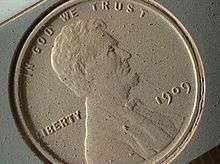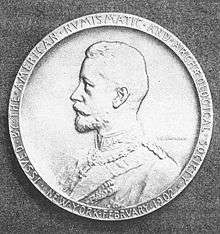Victor David Brenner
| Victor David Brenner | |
|---|---|
 Brenner holding a plaster model of the large design for the Lincoln cent (1909) | |
| Born |
Viktoras Baranauskas 12 June 1871 Šiauliai, Lithuania |
| Died | 5 April 1924 (aged 52) |
| Resting place | Mount Judah Cemetery Ridgewood, Queens |
| Nationality | Litvak-American |
| Occupation | Sculptor, engraver, medalist |
| Known for | Designing the Lincoln Cent |
Victor David Brenner (born Viktoras Baranauskas; June 12, 1871 – April 5, 1924) was a Litvak-American sculptor, engraver, and medalist known primarily as the designer of the United States Lincoln Cent.
Biography
Brenner was born to Jewish parents in Šiauliai, Lithuania. His name at birth was Viktoras Baranauskas, but he changed the name to Victor David Brenner, because this made it easier to obtain American citizenship.[1] He emigrated to the United States in 1890, living mostly in the New York City area. When Brenner arrived in America, he had little more to fall back upon except the trade taught him by his father — gem and seal engraving. This technical preparation included the tools of the sculptor's craft. He took night classes at Cooper Union. Brenner soon mastered English as he had mastered French.
Eight years later Brenner was in Paris, studying with the great French medalist, Oscar Roty at the Académie Julian. There he exhibited his work and obtained awards at the Paris Exposition of 1900. He returned to the United States, and from that time on his career prospered. He appeared to be on his way to the fulfillment of the splendid predictions made for his future by Rodin.
Brenner died in 1924 and is buried at Mount Judah Cemetery, Ridgewood, Queens County, New York.
Lincoln cent

Brenner is probably best known for his enduring Lincoln coin design, the obverse of which is the longest-running design in United States Mint history. Brenner's design had been picked by 26th U.S. President, Theodore Roosevelt, who had earlier posed for him in New York. Since arriving nineteen years earlier in the United States, Brenner had become one of the nation's premier medalists. Roosevelt had learned of Brenner's talents in a settlement house on New York City's Lower East Side and was immediately impressed with a bas-relief that Brenner had made of Lincoln, based on the early Civil War era photographer, Mathew Brady's photograph.
Roosevelt, who considered Lincoln the savior of the Union, the greatest Republican President and also considered himself Lincoln's political heir, ordered the new Lincoln penny to be based on Brenner's work and that it be produced to commemorate Lincoln's 100th birthday in 1909. The likeness of President Lincoln on the obverse of the coin is an adaptation of a plaque Brenner executed several years earlier and which had come to the attention of President Roosevelt in New York.[2]
Bronze bas-reliefs dated 1907 and signed by Brenner have been identified and some sold in auctions for as much as $3,900.[3]
Charles Eliot Norton of Harvard, whom Brenner counted among his friends, gave the sculptor an unpublished portrait of Lincoln which served Brenner as a basis for Lincoln's features. He also examined other portraits.[4]
When Brenner forwarded the model of the Lincoln cent to the Director of the Mint, the design bore his whole name, after the fashion of the signatures on the coinage of other countries, notably on the gold coins which Oscar Roty designed for France. The Director, however, decided to have the initials substituted for the name.[4]
Following the precedent of James B. Longacre, whose initials "JBL" (or simply "L") graced a number of U.S. coin designs for much of the latter half of the 19th century, Brenner placed his initials "VDB" at the bottom of the reverse between the wheat ear stalks.
Widespread criticism of the initials' prominence resulted in their removal midway through 1909, the design's first year of issue. In 1918, Brenner's initials returned as small letters below Lincoln's shoulder, where they remain today. (The incorporation of the designer's initials into a coin design is now commonplace in the U.S.)

A 1909 VDB US cent was mounted on the calibration target on the Mars Curiosity Rover. This is a nod to the rover's geologic mission and the common practice by geologists including a coin in photographs to document the size of objects.[5]
Works
Some of Brenner's most noteworthy sculptural works include:
- Rev. Dr Muhlenberg Medal (issued by the American Numismatic and Archaeological Society)
- Portrait-plaquette of Fridtjof Nansen
- Portrait medallion of J. Sanford Saltus
- Portrait medallion of C. Delacour
- Portrait-plaquette of Abraham Lincoln (the same plaquette that was used in the design of the Lincoln cent)
- Portrait medallion of Prince Heinrich of Prussia (1902)[4]
- Portrait bas-relief of John Paul Jones[4]
- Portrait bas-relief of Carl Schurz[4]
- Bust of Charles Eliot Norton[4]
- Seal of the New York Public Library[4]
- Portrait of Spencer Trask.[4]
- A Song to Nature in Schenley Plaza at the University of Pittsburgh
See also
Gallery
 Seal designed for the New York Public Library
Seal designed for the New York Public Library Bust of Charles Eliot Norton
Bust of Charles Eliot Norton Bas-relief of Carl Schurz
Bas-relief of Carl Schurz Medallion designed for the visit of Prince Heinrich of Prussia in 1902
Medallion designed for the visit of Prince Heinrich of Prussia in 1902 Bas-relief of John Paul Jones
Bas-relief of John Paul Jones A Song to Nature, part of the Mary Schenley Memorial Fountain located in Pittsburgh, was Brenner's first large sculpture in the round
A Song to Nature, part of the Mary Schenley Memorial Fountain located in Pittsburgh, was Brenner's first large sculpture in the round US One Cent
US One Cent
References
- ↑ Vieno JAV cento monetą sukūrė lietuvis - DELFI Žinios
- ↑ DAVID MARGOLICK (February 11, 2007). "Penny Foolish". New York Times. Retrieved 2008-08-08.
- ↑ "Victor David Brenner". Fine Art September 2008, May 2007. Rago Arts and Auction Center.
- 1 2 3 4 5 6 7 8 Gardner C. Teall, “The Lincoln Cent and its Maker,” Harper's Weekly, 1909, p. 24.
- ↑ Catalog Page for PIA16131
External links
- Works by or about Victor David Brenner at Internet Archive
- PCGS The Professional Coin Grading Service's biography of Victor David Brenner
- Leonard Forrer, Biographical Dictionary of Medallists (Vol 1, 1904) pp. 277–279